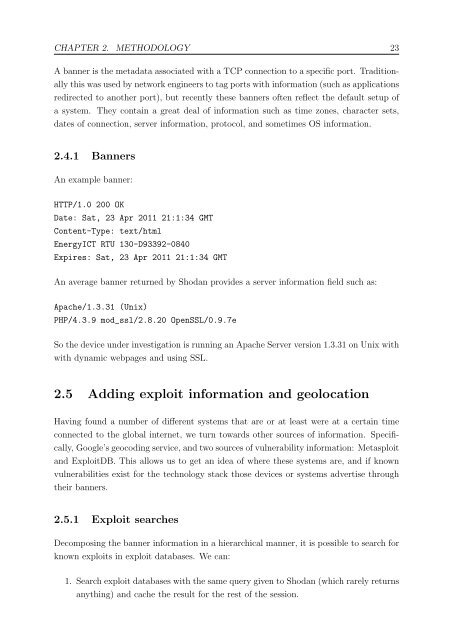Quantitatively Assessing and Visualising Industrial System Attack Surfaces
Quantitatively Assessing and Visualising Industrial System Attack Surfaces
Quantitatively Assessing and Visualising Industrial System Attack Surfaces
You also want an ePaper? Increase the reach of your titles
YUMPU automatically turns print PDFs into web optimized ePapers that Google loves.
CHAPTER 2. METHODOLOGY 23<br />
A banner is the metadata associated with a TCP connection to a specific port. Tradition-<br />
ally this was used by network engineers to tag ports with information (such as applications<br />
redirected to another port), but recently these banners often reflect the default setup of<br />
a system. They contain a great deal of information such as time zones, character sets,<br />
dates of connection, server information, protocol, <strong>and</strong> sometimes OS information.<br />
2.4.1 Banners<br />
An example banner:<br />
HTTP/1.0 200 OK<br />
Date: Sat, 23 Apr 2011 21:1:34 GMT<br />
Content-Type: text/html<br />
EnergyICT RTU 130-D93392-0840<br />
Expires: Sat, 23 Apr 2011 21:1:34 GMT<br />
An average banner returned by Shodan provides a server information field such as:<br />
Apache/1.3.31 (Unix)<br />
PHP/4.3.9 mod_ssl/2.8.20 OpenSSL/0.9.7e<br />
So the device under investigation is running an Apache Server version 1.3.31 on Unix with<br />
with dynamic webpages <strong>and</strong> using SSL.<br />
2.5 Adding exploit information <strong>and</strong> geolocation<br />
Having found a number of different systems that are or at least were at a certain time<br />
connected to the global internet, we turn towards other sources of information. Specifi-<br />
cally, Google’s geocoding service, <strong>and</strong> two sources of vulnerability information: Metasploit<br />
<strong>and</strong> ExploitDB. This allows us to get an idea of where these systems are, <strong>and</strong> if known<br />
vulnerabilities exist for the technology stack those devices or systems advertise through<br />
their banners.<br />
2.5.1 Exploit searches<br />
Decomposing the banner information in a hierarchical manner, it is possible to search for<br />
known exploits in exploit databases. We can:<br />
1. Search exploit databases with the same query given to Shodan (which rarely returns<br />
anything) <strong>and</strong> cache the result for the rest of the session.



